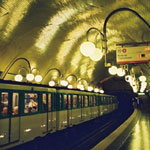
Paris Métro trains vary in length between three and six cars

FRONT PAGE
Site Search
About us
 

Barcelona Metro
Berlin U-Bahn
Guangzhou Metro
Guatemala City TransMetro
London Transport
London Underground
Madrid Metro
Mexico City Metrobus
New York City Subway
Paris Métro
Sao Paulo Metro
Seoul Metro
Singapore Metro
Tokyo Metro
Bus Rapid Transport Latin America
Bus Rapid Transport India
Trams in Europe

Worldwide | Elections | North America | Latin America | Europe | Asia | Africa |























 |
|
Paris Métro: Icon of
city's chic and style
By Andrew Stevens
9 February 2006: The Paris Métro has come to embody the iconic qualities of the French capital, with the distinctive art noveau stations of Hector Guimand considered to be the essence of that style. More recently, the system has become associated with introducing aromas at stations to counter odours and offering free massages to stressed passengers. Having opened the first line in 1900, most of the network was completed by the outset of war in 1939. Its 380 stations are served by 16 lines totalling 221km in length, which also serve the city’s six equally iconic rail termini. 1.3bn passenger journeys were made in 2004.
History | Design | User experience | Ownership | Expansion | Comparisons |
History
Paris first ‘public’ transport was the horse-drawn Omnibus (or coaches), which began service in 1828. In 1871 this was upgraded to a network of horse-drawn trams. With the arrival of the city’s large scale rail network which connected it to the France’s other cities, the Chemin de fer de Petite Ceinture was constructed as a small-scale circular rail route between them and opened in 1854, though it did not survive the eventual construction of the Métro.
The Métro was originally conceived as a rival to the burgeoning network of Victorian London but years of inertia resulted from disagreement over which arrondissments would be served by the system. Earlier plans were also ruled out as impractical. In 1900 the first line, Line 1, was opened, with extensions following in order to serve the Exposition Universelle that year. The first 10 lines were built by the City of Paris and operated by the Compagnie du Chemin de Fer Métropolitain de Paris (CMP), believed to be styled after London’s Metropolitan Railway (as the Undergound was then known). Gradual expansion took place after the formation of a second company, the Société du Chemin de Fer Electrique Nord-Sud de Paris in 1910, though the two then merged in 1930 under the CMP’s aegis. In 1948, the system was brought under state ownership by the creation of the Régie Autonome des Transports Parisiens (RATP), which also saw the Société des Transports en Commun de la Région Parisienne (who ran the city’s bus and former tram networks) included in the formation. The RATP is the transit authority and provider for Greater Paris to this day.
Design & layout
Paris’ Métro trains run on the same gauge as all other French lines, but other trains are incompatible with the network itself. Train length varies between three and six cars on each line, with a standard set for the line, dependent on demand. There are 14 principal lines and two supplementary routes. The network serves the outlying areas of the Greater Paris conurbation, with the lines generally crossing the city diametrically.
User experience
Paris’ Métro is feted the world over for the iconic grandeur of Hector Guimand but expecting the whole of the network to conform to this chic stereotype is like expecting to find tree-lined boulevards or cafes of chin-stroking intellectuals in the more deprived red belt suburbs. Thus the architecture may be variable but on the whole the system does conform to decent standards of cleanliness, especially when compared to the grime of some London stations. Smoking is banned on the network, though not so rigorously enforced as in some cities. Trains are frequent and punctual, though traversing the interchanges with the many stairs and tunnels can prove wearing and time consuming. Similarly, some stations on the network have reputations as crime hot-spots, as tourists straying into the suburbs can attest. When compared to London’s system however, prices are far more modest, with a single costing €1,40 or a day pass at €5,30.
Ownership
The Paris’ Métro remains under public ownership, with the Régie Autonome des Transports Parisiens (RATP) acting as both provider and transit authority.
Future expansion
After 60 years of zero expansion, the first stretch of the of €1bn state of the art driver-less Metro Est-Ouest Rapide (METEOR) was opened in 1998. Running between the Bibliotheque Francois Mitterrand and Madeleine stations, it creates extra capacity on the busiest line of the network. The Madelaine to Gare St Lazare was opened in 2003.
A further extension to Olympiades is planned at an estimated cost of €111 million. A further northern extension will follow after this.
After decades of absence, two tramlines were added to the Parisian public transport system during the 1990s, the T1 and T2 lines. The T3 line will be opened later this year.
National comparisons
In addition to Paris, several rapid transit systems operate in French cities. These include the rubber-tired driver-less Véhicule Automatique Légers in Lyon (opened 1983), Toulouse (1993) and Rennes (2002) and the Metro of Lyon (1978) and Marseille (1977). Several cities also operate light rail systems, with several more planned or already under construction.
|
|

|































